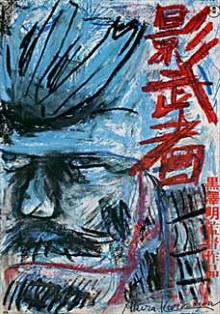
Akira Kurosawa made this in 1980, at the age of 70. The legendary director would go on making films nearly until he died in 1998 but this together with Ran in 1985 are considered the last two films that are truly great. Apparently after a string of commercial failures, Kurosawa had such difficulty raising money to make new films that he attempted to commit suicide in the 1970s. Kagemusha was made possible only when Hollywood directors who are great fans of his work helped him raise funds for the film.
Set during the Sengoku period, the film tells the story of the Takeda clan. Takeda Nobukado brings to the attention of his brother, Takeda Shingen, the daimyo of the clan, a common thief who looks identical to the ruler. Shingen agrees that the thief be trained as his double, a so-called kagemusha or shadow warrior. Some time afterwards, while the Takeda army is besieging a castle controlled by the faction led by Tokugawa Ieyasu, Shingen is shot by arquebus-wielding sniper. Before he passes, he leaves instructions that his death must be concealed for a period of three years and that during this time the Takeda army must never venture out beyond the borders of their lands. The Takeda’s enemies, Ieyasu and his ally Oda Nobunaga, suspect that Shingen has died and make every effort to discover the truth. This means that the double, under the guidance of Nobukado and the other top advisers who know the truth, must take care to keep up the charade even to family members and close associates.
Clocking in at three hours, Kagemusha is comparable in length to the other Kurosawa films we’ve seen so far. Unfortunately while those other films have always been so filled with delight and wonder that you barely feel their length, this one is so ponderous and some parts are so repetitive that I found myself watching the time. I believe tt could easily be edited down by at least a half hour and be a much better film for it. The reason is that the plot here is so one-dimensional: it’s all about the body double doing his best to keep up the impersonation while Ieyasu and Nobunaga keep testing that deception. The attempts at humor mostly fall flat, though I did appreciate the cameo appearance of the two leads from The Hidden Fortress and there’s too little development of the characters. The relationship between the double and Shingen’s grandson and heir Takemaru is a potential point of interest but that too is a thread that is dropped rather than resolved.
That said, there are plenty of interesting themes in this film that are worth in-depth examination. I was impressed by how Kurosawa ensures that Shingen remains the main character even after his death. Both Ieyasu and Nobunaga believe that it is his stratagems that they must contend with and so it is even though other people are the ones carrying it out. The character of the double outside of his role as Shingen is so immaterial that he eventually immerses himself completely in it and behaves as if he is possessed by the deceased man’s spirit. This perhaps also dovetails with the nature of the battles between the Takeda and their enemies. This is most evident in the climactic fight in which we see the Takeda mostly using cavalry armed with swords and spears while the forces of Nobunaga and Ieyasu employ firearms. I can’t but think that this is saying something about how as Shingen passes, so goes with him the last gasp of the traditional samurai way of warfare.
I also enjoyed watching how Kurosawa works with colors. His choices are bold to say the least and he delights in carefully choosing just the right backdrops for his outdoor scenes. Near the end, a huge rainbow that seemingly wraps around his lands is used to symbolize Shingen’s wish that his forces stay at home. I have no idea how Kurosawa managed to get this on film. The film features large-scale battles, larger than the ones I’ve seen in his previous films. They get confusing at times as they mostly seem to consist of soldiers maneuvering around to get into a good position. We rarely get to see melee combat but plenty of soldiers die from being shot. It’s different from the usual but it also lacks the drama and emotional highs of one on one fights.
Overall I found this to be a solid film that is well worth watching but it’s also true that it’s nowhere close to the timeless classics that are his earlier works. It’s heartening that Kurosawa kept wanting to make films so late in life and that he still did good work, but if you have time for only a limited number of them, then it’s probably best to stick to the earlier ones.